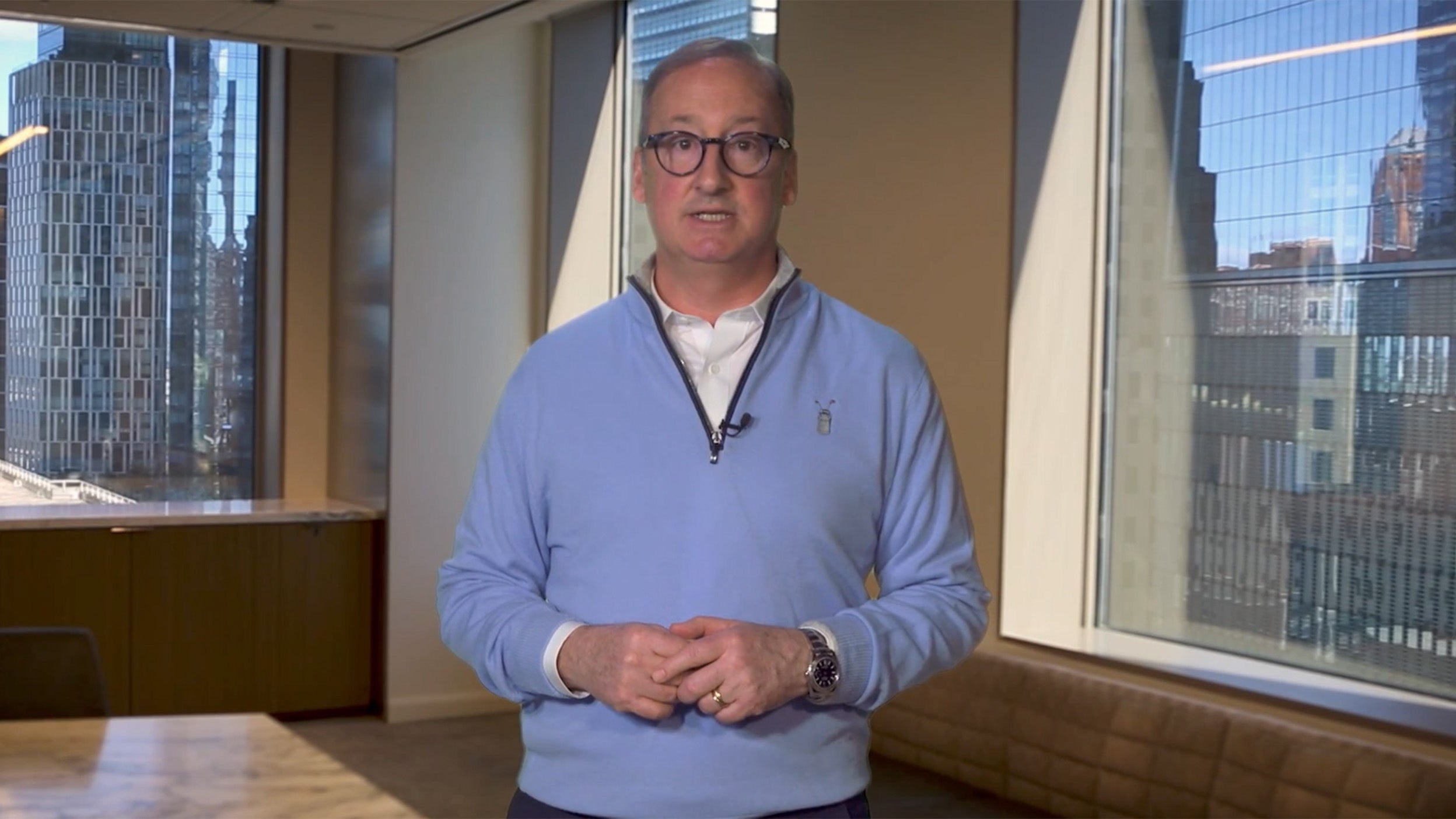
ETF The strategic advantage of AAA-rated CLO Notes
Invesco Private Credit’s Kevin Petrovcik discusses new developments for AAA-rated Collateralised Loan Obligation (CLO) note investments and their potential advantages.

2024 was a strong year for loan returns driven primarily by robust coupon, in line with our expectations.
The US economy showed strength in 2024, but persistent inflation and rising delinquency rates suggest a cautious yet promising outlook for direct lending in 2025.
The capital solutions opportunity set is growing exponentially due to historical private equity buyouts, pandemic impacts, and rising base rates, despite many underlying businesses being strategically and operationally sound.
In 2024, the US leveraged loan market achieved an 9.05% full year return, surpassing expectations. This performance was driven by robust coupon income of 9.65%, despite a slight price detraction of -0.60%. The market benefited from resilient economic growth, stable loan spreads, and a benign credit environment. Base rates declined from 5.33% to 4.51%, while loan spreads compressed due to heightened repricing activity. The loan default rate remained low at 0.91%, with distressed exchanges helping to improve recoveries. Strong demand from CLO formations and retail investors supported the market, although new issuance was relatively muted due to limited M&A and LBO activity.
Source: PitchBook Data, Inc; Morningstar LSTA US Leveraged Loan Index as of December 31, 2024. The Morningstar LSTA US Leveraged Loan Index represents US leveraged loans. An investment cannot be made in an index. Past performance does not predict future returns.
In 2025, the US leveraged loan market is expected to deliver total returns of 7.5-8.0%, powered by high carry and price stability, partly offset by mild erosion in spread and base rates. The market anticipates the US Federal Reserve (Fed) will continue easing rates, albeit slowly, influenced by moderating disinflation and the Trump Administration’s inflationary policy risks. US and global growth are expected to remain resilient, with a lower loan default rate of 3.25-3.75%. Despite limited price appreciation potential, strong fundamentals and supportive market technicals should maintain price stability, with repricing activity expected to moderate compared to 2024.
Source: PitchBook Data, Inc. as of December 31, 2024, updated quarterly. Base rate reflects the average during the quarter. Uses three-month LIBOR (prior to 2023) or SOFR (2023 or later) plus the weighted average institutional spread. (Purple) Forecasted coupon for 4/15/25, 7/15/25, 10/15/25, 1/15/26, and the same dates in 2026 and 2027 using average trailing 4 quarters spread levels and forward 3m SOFR rates as of January 6, 2025. 2025-2027 represented by the forecasts as of 1/15/25. With dashed purple line representing average projected coupon in 2026-2027. There can be no assurance that any projected returns can be realized.
From a macroeconomic perspective, we expect US growth will remain resilient and global growth will accelerate in response to broadly easing monetary conditions. The Trump Administration does not materially alter our near-term growth expectations, but it does widen the band of plausible economic outcomes in the coming years. President Trump’s re-election heightens the odds of disruption to the status quo on numerous fronts - global trade, international alliances, immigration, the scope and efficiency of government agencies, as well as several other domains of American society and industry. Disruption of the status quo is inherently hazardous to incumbent loan issuers, particularly those whose revenues or competitive moats depend on the current regulatory edifice. We expect winners and losers will emerge from this impending shake up, so credit selection will be critical even in a scenario of accelerating growth.
In 2025, the US CLO market is expected to continue the strong trends from 2024. Demand is driven by banks and insurers favoring CLO liabilities, international banks’ continued purchases, and the emergence of CLO ETFs. Private credit CLO issuance is also expected to remain high. Despite muted net issuance due to amortizations and called CLOs, refinance and reset activity will likely continue at a high pace. Tightening CLO spreads could further drive demand, with primary CLO spreads potentially tightening to SOFR + 110-120bps. The main risk to this forecast is the macroeconomic outlook.
For our complete analysis, read “US Senior Loans and CLO Market Outlook.”
The European leveraged loan market returned 8.53% for the full year 2024, aligning with expectations. Loan prices appreciated due to an improving macroeconomic landscape, with growth reflected in PMI and GDP metrics, despite Germany’s underperformance. Disinflation trends allowed the European Central Bank (ECB) to cut deposit rates, supporting a positive market environment. The Credit Suisse Western European Leveraged Loan Index posted consistent monthly returns, with significant growth in CLO origination driven by tightening spreads. The market saw record institutional loan volume, primarily from repricing and extension transactions, mitigating maturity-wall risks. Overall, the market benefited from improving fundamentals and confidence, with expectations for continued positive dynamics in 2025.
Source: S&P/UBS, Credit Suisse, Barclays, Bloomberg as of December 31, 2024. Past performance does not predict future returns. The S&P UBS Western European Leveraged Loan Index represents European Loans, the Credit Suisse Western European High Yield Index represents European High Yield, and the Bloomberg Euro Aggregate Corporate Total Return Index represents European Investment Grade. All Euro-based indices are hedged to EUR. An investment cannot be made directly in an index. All Euro-based indices are hedged to EUR. An investment cannot be made in an index.
The Euro area is expected to maintain a low-but-positive growth trajectory, despite uncertainties from the US election and potential tariffs. Increased domestic demand, driven by higher disposable incomes and a less restrictive ECB, along with disinflation and monetary stimulus, should support corporate fundamentals and reduce interest expense risks. The ECB’s rate cuts are anticipated to continue, providing further monetary stimulus and supporting GDP growth and EBITDA improvements. This environment is expected to keep idiosyncratic risks in check and create a relatively benign environment for corporate distress, with default rates likely to remain below non-recessionary averages.
Source: PitchBook Data, Inc. as of December 31, 2024 in Euro billions. Updated quarterly.
CLO issuance is expected to remain strong, supported by experienced managers and robust investor demand. The market could see record levels of issuance if the weighted average cost of debt tightens alongside increased supply of assets. M&A and LBO activity are expected to increase in 2025, driven by lower financing costs and higher C-suite confidence as recessionary fears fade. Loan refinancing is expected to moderate, and the near-term maturity wall has significantly decreased, reducing refinancing pressures. Overall, the market is expected to benefit from positive dynamics, with a constructive outlook for loan spreads and continued strong demand for CLOs.
For our complete analysis, read “European Senior Loans and CLO Market Outlook.”
The US economy continued to demonstrate strength in 2024, although core PCE, the Fed’s preferred measure of inflation, has proven more stubborn than expected. Further, labor markets continued to exhibit volatility, pandemic savings have become largely depleted, delinquency rates on auto loans and credit cards have continued to trend higher, and credit card balances are at the highest level we have seen in a decade. All this to say, that while we believe 2025 should be a compelling opportunity for the Direct Lending asset class, we remain disciplined, focused and cautious.
With the new US government administration coming into office, we are anticipating continued strength in the economy, coupled with potential inflationary pressures from some of the anticipated government policy changes. Should we experience a more restrictive tone, or at least a slower easing of monetary policy, we believe the US economy is well positioned to weather any challenges given GDP growth is trending close to 3.0% currently.
Importantly, we continue to see a very favorable setup for direct lending in 2025. Private equity firms continue to face mounting pressures from investors to provide liquidity as well as deploy the significant amount of new capital that has been raised in recent years. A conclusion to the election process without incident has been well received by the equity markets, which in turn has fueled a meaningful pickup in M&A volumes. With expectations for a higher-for-longer rate environment, we expect the risk/return dynamics for Direct Lending to continue to offer a compelling value proposition in 2025.
We continue to see exponential growth in our capital solutions opportunity set which has been a function of two decades of private equity buyouts in an effectively zero interest rate environment, followed by a pandemic, massive cost structure inflation, and approximately 500 basis points of base rate increase. These opportunities remain unique historically in the special situations universe in that there is nothing inherently distressed about many of these underlying businesses. They are, in general, strategically and operationally sound with excellent management teams and private equity sponsors.
However, private equity owners have been constrained by their capital structures, unable to grow equity value during the past decade. New product development, geographic expansion, accretive acquisitions – all growth avenues typically pursued by sponsors – have been sacrificed to service leverage levels that were only sustainable prior to today’s more restrictive monetary policy. Many of these companies have capital structures with debt that is unimpaired (worth “par”) where substantial equity value remains. It is just a matter of math that equity accounts have not grown since these buyouts occurred, given the cost of capital for floating rate borrowings has essentially doubled over the course of the last three years.
Invesco is one of the world’s largest and most experienced private credit managers, catering to a wide range of client objectives and risk tolerances.
We follow a consistent credit process centred on due diligence, conservative underwriting, and risk mitigation. The idea is to preserve capital while targeting attractive risk-adjusted returns.
Contact us to learn more about our capabilities in:
Private credit is an asset class that can generally be defined as non-bank lending. In other words, it includes privately negotiated loans and debt financing. The private credit market typically serves borrowers that are too small to access public debt markets, or that have unique circumstances requiring a private lender.
Broadly syndicated loans are privately arranged debt instruments comprised of below investment grade borrowers. They are made to large cap companies and syndicated by intermediary commercial and investment banks. These loans are then distributed to multiple institutional investors.
CLOs, or collaterialised loan obligations, are securitised versions of broadly syndicated loans. CLOs create portfolios of hundreds of loans and structure them into different tranches with different risk/return profiles. This allows investors to choose their preferred balance of risk and return, which benefit from a collateralised structure.
Typically, CLO notes offer a premium to other securitised vehicles because of the complexity of understanding the underlying private loans and the uniqueness of each CLO structure. CLO notes are registered securities and trade and settle like bonds.
Direct lending means providing capital to companies or businesses without the benefit of an intermediary. In other words, you’re directly lending to a company.
Distressed credit involves investing in the senior debt of companies at significant discounts to par, usually due to perceived fundamental weakness.
Returns are generated by investing in companies where, over the longer-term and through various actions, meaningful upside potential can be unlocked.

Invesco Private Credit’s Kevin Petrovcik discusses new developments for AAA-rated Collateralised Loan Obligation (CLO) note investments and their potential advantages.

Explore the benefits of incorporating AAA-rated CLO notes may provide to an investment strategy including consistent income potential and possible hedge against interest-rate volatility.

How Collateralised Loan Obligations (CLOs) offer portfolio diversification and an attractive potential return profile in today’s evolving financial landscape.
The value of investments and any income will fluctuate (this may partly be the result of exchange rate fluctuations) and investors may not get back the full amount invested.
Alternative investment products may involve a higher degree of risk, may engage in leveraging and other speculative investment practices that may increase the risk of investment loss, can be highly illiquid, may not be required to provide periodic pricing or valuation information to investors, may involve complex tax structures and delays in distributing important tax information, are not subject to the same regulatory requirements as mutual portfolios, often charge higher fees which may offset any trading profits, and in many cases the underlying investments are not transparent and are known only to the investment manager.
Information is provided as at 19 February 2025, sourced from Invesco unless otherwise stated.
This is marketing material and not financial advice. It is not intended as a recommendation to buy or sell any particular asset class, security or strategy. Regulatory requirements that require impartiality of investment/investment strategy recommendations are therefore not applicable nor are any prohibitions to trade before publication. Views and opinions are based on current market conditions and are subject to change.
Israel: This document may not be reproduced or used for any other purpose, nor be furnished to any other person other than those to whom copies have been sent. Nothing in this document should be considered investment advice or investment marketing as defined in the Regulation of Investment Advice, Investment Marketing and Portfolio Management Law, 1995 (“Investment Advice Law”). Neither Invesco Ltd. nor its subsidiaries are licensed under the Investment Advice Law, nor does it carry the insurance as required of a licensee thereunder.
EMEA4238444